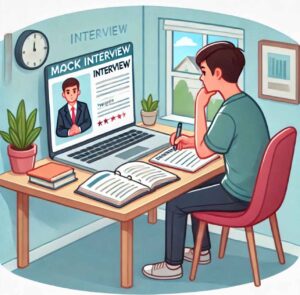Welcome Blessings!
(Tap 🔽 to see more topics!)


You walk into an interview feeling confident, your resume polished, and ready to shine. Then, somehow, the conversation turns, and you’re left wondering, ‘What just happened?‘ Behavioral interviews, asking you to tell stories about past experiences, can feel like going through a minefield. It’s not just about knowing your skills. But, it’s about showing and proving them with real-life examples.
It is like trying to explain how to ride a bike without ever having done it. You can talk about the pedals and handlebars, but what about the balance and coordination? That’s what they’re looking for. And just like forgetting an essential ingredient while baking, even seasoned job seekers can trip over hidden traps in these interviews.
Whether you’re someone who’s climbed the career ladder or just starting, everyone wants to make a strong impression. Sometimes, it’s the little things, the subtle errors, that can make the most significant difference. It’s like hitting a tiny pothole in the road. You might not see it coming, but it can still throw you off course.
So, let’s pull back the curtain and look at the top 8 common mistakes people make in behavioral interviews. Today, you will learn why these things happen, and more importantly, you’ll learn simple, practical ways to steer clear of them. Because landing that dream job shouldn’t feel like a guessing game. It’s about understanding the rules of the road and driving with confidence!
Do you know when you’re telling a story that lands flat? That’s how many behavioral interview answers feel when they’re missing something crucial. It’s like explaining a movie plot without mentioning the main character’s goal. You get the general idea but missing the story’s heart.
A common mistake? Not using the STAR method. It’s just a simple way to structure your answers so they show off your skills. Think of it like a recipe for a good story.
Many people give a general answer, like, “Yeah, I worked on a team project.” That’s like saying, “I went to a restaurant.” Okay, which restaurant? What did you eat? Was it good? You need details.
How to make sure you nail it?
Don’t just tell them you can do something. Show them a real story using the STAR recipe. It’s like showing them a picture instead of just describing it. They’ll get it, and they’ll remember you.

It’s easy to fall into the ‘we’ trap. You’re talking about a project. Suddenly, it’s all about what the team did. And yeah, teamwork is fantastic! But this interview is about you. It’s like going to a concert, and the singer keeps pointing at the band. It’s an incredible band, but you paid to see the singer!
Many people accidentally gloss over their contributions, and that’s a missed opportunity. Imagine you’re on a sports team. Saying, “We won the game,” is way different than saying, “I scored the winning goal.” Both are true, but one tells a much more specific story. But, how do you avoid sounding like a broken record saying “we”?
Remember, they’re not hiring the team. They’re hiring you, so they need to see what you bring to the table. Don’t be shy about highlighting your contributions. It’s not bragging. It’s just being clear about your skills.
Do you know those stock phrases people use in interviews? ‘I’m a hard worker,’ ‘I’m a team player,’ and they say you like ‘food’ when someone asks about your favorite restaurant. It’s not wrong, but it’s unhelpful. It’s like describing a beautiful painting by saying, “It’s colorful.” You’re missing all the details that make it enjoyable.
The problem with being vague is that everyone else is probably being vague, too. You’re just blending into the background. Imagine a room full of people all wearing the same gray suit. No one stands out.
See the difference? It’s about giving them a clear, vivid picture of your abilities, not just a vague outline. You’re not just saying you can do something but proving it.

It’s like going on a first date and talking about your stamp collection when they’re really into rock climbing. You might be super passionate about stamps, but it’s not what they’re looking for. That happens when you don’t connect your interview answers to the job description. Many people go into interviews with pre-prepared stories, which is excellent! But if those stories don’t show you have the skills they’re looking for, you’re talking to a brick wall. They need to see how you fit their puzzle.
1. Become a Job Description Detective.
2. Tailor Your Stories.
3. Make the Connection Clear.
They are looking for a specific tool for a job. Your interview answers should show them that you are that exact tool. Keep in mind that you are not just telling stories. You’re showing them that you’re the perfect fit. Make it obvious and relevant.
Have you ever been stuck in a conversation where someone just…keeps talking? Or, on the flip side, have you felt like pulling teeth to get someone to say anything? That’s the tightrope walk of interview answers. You’ve got to find that sweet spot, like getting your coffee how you like it.
It’s a common mistake, honestly. People either spill their entire life story or give short answers, leaving them wondering if they even want the job. It’s tough because you want to be thorough but don’t want to bore the interviewer.
1. Too much talking.
2. Too little talking.
How do you find the “just right” balance?
It’s about respecting the interviewer’s time while still showcasing your abilities. It’s like telling a good joke. You must get to the punchline without losing the audience.
You can have all the correct answers, but if you deliver them like you’re reading a grocery list, people won’t connect. That’s the problem with not showing enough enthusiasm in an interview. Even if you’re the most qualified person in the room, if you sound bored, they’ll think you are bored.
If someone’s telling you about something they love, you expect to see a spark in their eyes and a little energy in their voice. It’s the same with a job interview. They want to know that you’re genuinely excited about the opportunity. How to avoid sounding like you’d rather be anywhere else?
They’re looking for someone who’s not just qualified but also enthusiastic. They want someone who’ll bring energy to the team. Remember, let your passion shine through. It’s not about putting on an act. But, it’s about showing them the real you, the you who’s genuinely excited about the chance to work with them.
Nobody likes that person at the party who only talks about themselves. It’s the same in an interview. You have to show your stuff, but there’s a fundamental difference between confidence and just plain bragging. You can say you made a great cake, but if you only talk about how amazing you are and ignore the recipe or anyone who helped, it just feels…off.
It’s a common trap. You want to impress, so you overdo it. You end up sounding like you’re only interested in your glory, and that’s a turn-off.
You’re telling a story, and you’re the main character, but you’re not the only character. You’re part of a bigger picture. It’s about showing you can shine while also recognizing the contributions of others. That’s what makes a good teammate and what interviewers are looking for.
Nobody’s perfect, and pretending you are in an interview? That comes across as, well, not genuine. You know those “What’s your weakness?” questions? They’re designed to see your self-awareness, not trip you up. But many people make the mistake of saying they have no weaknesses or giving fake-humble answers like, “I work too hard.”
Look, everyone has things they’re working on. It’s about being authentic. Saying you’re a “perfectionist” is a classic, but it’s like saying you’re a superhero with no kryptonite. It just doesn’t ring true.
For example, instead of saying, “I’m bad at public speaking,” you could say:
“Public speaking has always been a challenge for me. I tend to get nervous, especially in larger groups. However, I’ve been actively working on this by joining a local group and practicing presentations in front of my colleagues. I’ve also started using techniques like deep breathing and visualization to manage my anxiety, and I’ve already seen improvements in my confidence.”
See the difference? It shows you’re honest, aware of your challenges, and taking steps to overcome them. That’s what interviewers want to see. It’s like admitting you’re not a master chef but taking cooking classes and trying new recipes. They respect the effort.

Interviews can feel like a high-wire act. You’re trying to balance telling your story with showing your best self while hoping you don’t slip up. But honestly, it’s not about being perfect. It’s about being authentic. Think of these behavioral interviews as sharing a good story around a campfire. You want to keep people engaged, show them what you’re made of, and leave them feeling good. Considering these eight common pitfalls, you’re giving yourself a map to go through the conversation smoothly. It’s about understanding that they’re not just looking for someone who can do the job but someone who fits and would enjoy working with.
When you’re in that interview, remember, you’re having a conversation. You’re showing the interviewer who you are, the lessons you’ve learned, and how you can bring something extraordinary to their team. It’s about building a connection, not just answering questions.
If you’re feeling a little nervous about your following interview, don’t worry! Everyone does. Take a moment to think about your stories, practice using the STAR method, and remember that you can do it. If you want to learn more about crafting those impactful stories or have a specific interview, read our other articles for more info. Voila! Until next time!